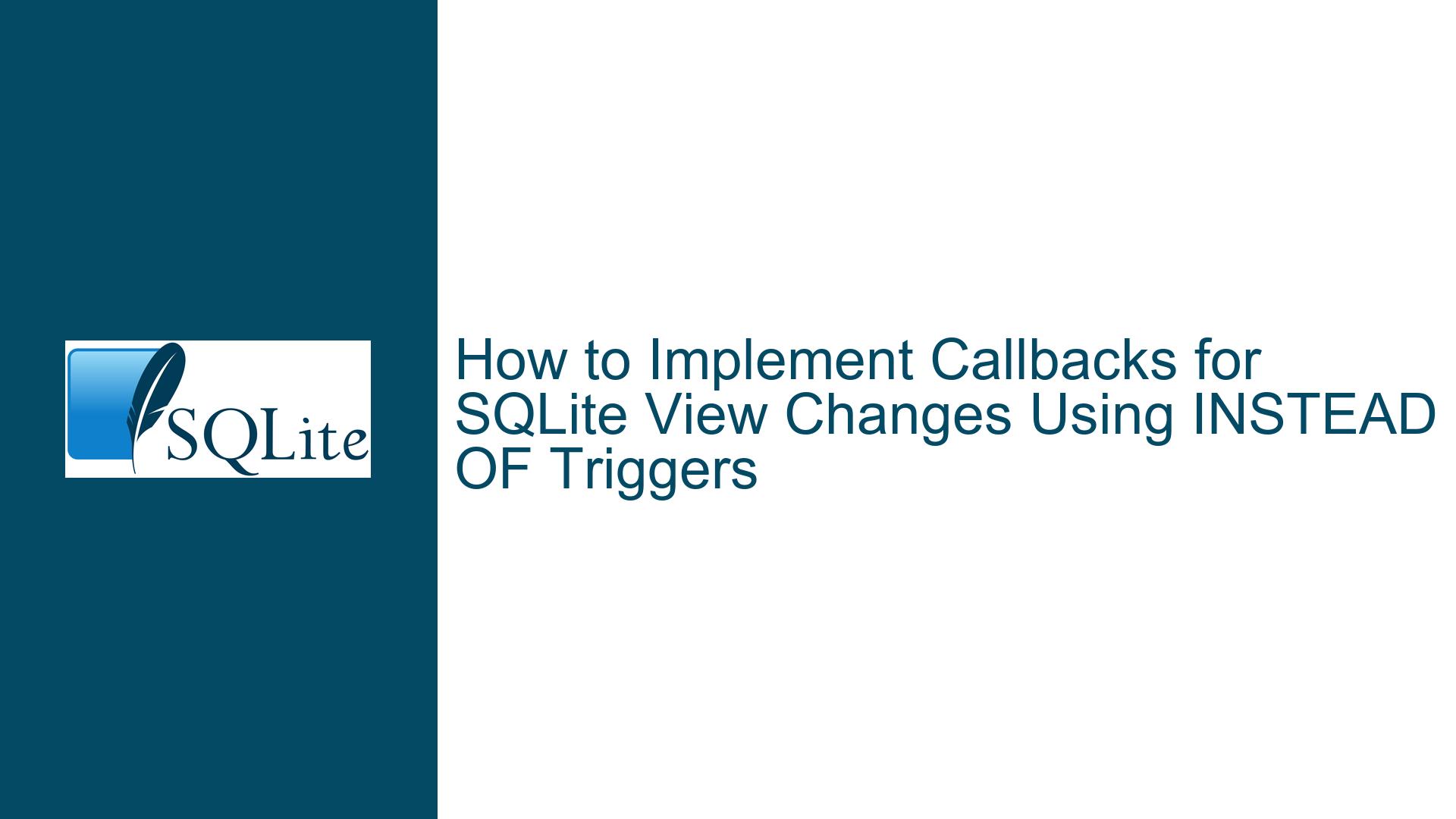How to Implement Callbacks for SQLite View Changes Using INSTEAD OF Triggers
Understanding SQLite Views and Their Read-Only Nature
SQLite views are virtual tables that represent the result of a predefined SQL query. Unlike regular tables, views do not store data themselves; instead, they dynamically retrieve data from one or more underlying tables whenever they are queried. This read-only nature of views is a fundamental characteristic that distinguishes them from regular tables. Since views do not hold data, any attempt to directly modify a view would be ambiguous—SQLite would not know how to propagate those changes back to the underlying tables. This is why SQLite does not support direct modifications to views.
However, the read-only nature of views does not mean they are entirely static or unchangeable. Changes to the underlying tables will reflect in the view the next time it is queried. For example, if a view CustomerSummary is defined to aggregate data from a Customers table, any updates to the Customers table will immediately affect the results returned by the CustomerSummary view. This dynamic behavior is one of the key advantages of using views, as they provide a consistent and up-to-date representation of the data without requiring manual updates.
Despite their dynamic nature, views cannot be directly modified because they are not physical storage entities. This limitation becomes apparent when attempting to use SQLite’s SQLITE3_UPDATE_HOOK function, which is designed to trigger callbacks when changes occur in regular tables. Since views do not store data, the SQLITE3_UPDATE_HOOK function does not apply to them. This leaves developers wondering how to implement a mechanism to detect or respond to changes in the data presented by a view.
The Role of INSTEAD OF Triggers in Modifying View Behavior
To address the challenge of detecting changes in views, SQLite provides a powerful feature called INSTEAD OF triggers. These triggers allow developers to intercept attempts to modify a view and define custom logic to handle those modifications. Unlike regular triggers, which are associated with tables and fire in response to specific events (e.g., INSERT, UPDATE, DELETE), INSTEAD OF triggers are specifically designed for views. They enable developers to simulate modifications to a view by redirecting those changes to the underlying tables.
An INSTEAD OF trigger works by replacing the default behavior of a modification operation on a view. For example, if an INSERT operation is attempted on a view, the INSTEAD OF trigger intercepts the operation and executes a predefined set of SQL statements instead. These statements can include logic to update the underlying tables, log the change, or even notify external systems. This mechanism effectively allows developers to "modify" a view by propagating changes to the appropriate tables.
The syntax for creating an INSTEAD OF trigger is similar to that of a regular trigger, with the key difference being the use of the INSTEAD OF keyword. For example, the following trigger intercepts INSERT operations on a view named CustomerSummary and redirects them to the underlying Customers table:
CREATE TRIGGER CustomerSummaryInsertTrigger
INSTEAD OF INSERT ON CustomerSummary
BEGIN
INSERT INTO Customers (Name, Email, TotalPurchases)
VALUES (NEW.Name, NEW.Email, NEW.TotalPurchases);
END;
In this example, the trigger captures the INSERT operation on the CustomerSummary view and inserts the new data into the Customers table. The NEW keyword is used to reference the values being inserted into the view. Similar triggers can be created for UPDATE and DELETE operations, allowing developers to define custom behavior for all types of modifications.
Implementing Callbacks for View Changes Using INSTEAD OF Triggers
While INSTEAD OF triggers provide a way to handle modifications to views, they do not directly support callbacks or notifications. However, by combining INSTEAD OF triggers with additional logic, developers can implement a callback mechanism to detect and respond to changes in views. This approach involves using triggers to log changes to a separate table or invoke external functions when modifications occur.
One common technique is to create a change log table that records all modifications made to a view. The INSTEAD OF trigger can insert a new row into this table whenever a change is detected. External applications can then monitor the change log table for new entries and take appropriate action. For example, the following trigger logs INSERT operations on the CustomerSummary view:
CREATE TRIGGER CustomerSummaryInsertTrigger
INSTEAD OF INSERT ON CustomerSummary
BEGIN
INSERT INTO Customers (Name, Email, TotalPurchases)
VALUES (NEW.Name, NEW.Email, NEW.TotalPurchases);
INSERT INTO ChangeLog (ViewName, Operation, Timestamp)
VALUES ('CustomerSummary', 'INSERT', CURRENT_TIMESTAMP);
END;
In this example, the trigger not only inserts the new data into the Customers table but also logs the operation in the ChangeLog table. The ChangeLog table can include additional columns to store details such as the user who made the change or the specific values that were modified. External applications can query the ChangeLog table periodically to detect changes and invoke callbacks as needed.
Another approach is to use SQLite’s user-defined functions (UDFs) to implement callbacks directly within the trigger. UDFs allow developers to extend SQLite’s functionality by defining custom functions in a programming language such as C or Python. These functions can be invoked from within a trigger to send notifications or perform other actions. For example, the following trigger uses a UDF named NotifyChange to send a notification when an INSERT operation occurs:
CREATE TRIGGER CustomerSummaryInsertTrigger
INSTEAD OF INSERT ON CustomerSummary
BEGIN
INSERT INTO Customers (Name, Email, TotalPurchases)
VALUES (NEW.Name, NEW.Email, NEW.TotalPurchases);
SELECT NotifyChange('CustomerSummary', 'INSERT', NEW.Name);
END;
In this example, the NotifyChange function is called with details about the change, such as the view name, operation type, and the name of the customer being inserted. The function can then send a notification to an external system or invoke a callback function in the application.
Best Practices for Using INSTEAD OF Triggers and Callbacks
When implementing INSTEAD OF triggers and callbacks, it is important to follow best practices to ensure the solution is robust, efficient, and maintainable. One key consideration is to minimize the overhead introduced by the triggers. Since triggers execute for every modification operation, they can impact performance if they perform complex or time-consuming tasks. To mitigate this, developers should optimize the logic within the triggers and avoid unnecessary operations.
Another best practice is to use transactions to ensure atomicity and consistency when modifying multiple tables or invoking callbacks. By wrapping the trigger logic in a transaction, developers can ensure that all changes are applied atomically and that the system remains in a consistent state even if an error occurs. For example, the following trigger uses a transaction to ensure that both the INSERT operation and the change log entry are applied together:
CREATE TRIGGER CustomerSummaryInsertTrigger
INSTEAD OF INSERT ON CustomerSummary
BEGIN
BEGIN TRANSACTION;
INSERT INTO Customers (Name, Email, TotalPurchases)
VALUES (NEW.Name, NEW.Email, NEW.TotalPurchases);
INSERT INTO ChangeLog (ViewName, Operation, Timestamp)
VALUES ('CustomerSummary', 'INSERT', CURRENT_TIMESTAMP);
COMMIT;
END;
In this example, the BEGIN TRANSACTION and COMMIT statements ensure that both the INSERT operation and the change log entry are applied as a single unit of work. If an error occurs during the trigger execution, the transaction can be rolled back to undo any partial changes.
Finally, developers should document the purpose and behavior of each trigger to ensure that the system remains maintainable over time. This includes documenting the tables and views affected by the trigger, the operations it intercepts, and the logic it implements. Clear documentation helps other developers understand the system and make changes without introducing unintended side effects.
Conclusion
While SQLite views are inherently read-only, the use of INSTEAD OF triggers provides a powerful mechanism to simulate modifications and implement callbacks for changes. By intercepting modification operations and redirecting them to the underlying tables, developers can effectively "modify" views and respond to changes in a controlled manner. Combining INSTEAD OF triggers with change log tables or user-defined functions enables the implementation of callback mechanisms that notify external systems or applications when changes occur. By following best practices and optimizing the trigger logic, developers can create robust and efficient solutions that leverage the full potential of SQLite views.






